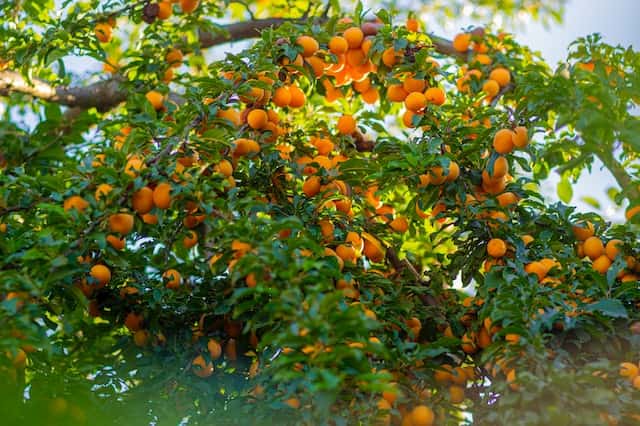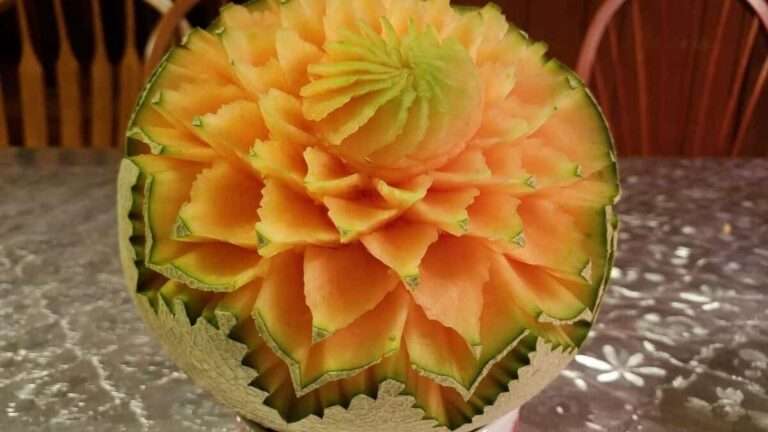44 amazing apricot information you need to know
Did you know that people have been eating apricots for more than 6000 years?
- During the course of archaeological digs at the Garni Temple and the Shengavit village, which together have a history of 6,000 years, seeds of the apricot fruit were found.
- In Egypt, a drink known as amar al-dn is often made by first drying apricots, then adding a sweetener, and finally using the apricots in the drink.
- In the 17th century, apricot oil was used as a treatment for a variety of conditions, including tumours, ulcers, and swellings. Around the same time, immigrants from England carried apricots to the colonies they had established in the new world.
- The word “apricot” comes from the Greek word “praikókion,” which means “cooked” or “ripened beforehand.” The word “praecocia” means “cooked.” The term initially appeared in English in the 16th century under the spelling abrecock. It was derived from the Middle French word aubercot or, later, abricot, which in turn came from the Catalan word a(l)bercoc.
- In Europe, apricots were traditionally thought to as an aphrodisiac, whereas in China, the kernel of the apricot was used in traditional Chinese medicinal practises. Apricots were referred to be the “moons of the faithful” by the Chinese. It was believed that they had the ability to increase a woman’s chances of becoming pregnant.

Apricot nutrition values and health benefits
- Apricots are an excellent source of the minerals potassium and phosphorus, as well as the antioxidant beta-carotene, which is transformed into vitamin A in the body. In addition, they are a good source of calcium, iron, and magnesium, as well as vitamin C and folate.
- Dried fruit is often higher in vitamin and mineral content than fresh fruit, despite the fact that it is a more concentrated source of calories and sugar than fresh fruit. The same number of vitamins and minerals can be found in dried apricots as can be found in fresh ones.
- Apricots, whether eaten fresh or dried, are a good source of soluble fibre. Soluble fibre is a kind of fibre that helps transport faeces more easily through the digestive system by attracting and retaining water. Consuming between 5 and 10 grams of soluble fibre on a daily basis has been shown to reduce levels of LDL cholesterol, often known as “bad” cholesterol, by up to 11 points and maybe even more.
- Dried apricots are often eaten with nuts, as is the case with trail mixes and other similar foods. Because nuts are naturally high in fat, they have a tendency to reduce both the pace at which the stomach empties and the rate at which glucose is released into the circulation. The rise and fall of blood sugar is more equal when nuts are paired with dried fruits with a low to medium glycaemic index, such as apricots.
- Beta-carotene, which gives apricots and other orange fruits and vegetables like carrots, pumpkins, and mangoes their vibrant colour, is also responsible for the colour of apricots. There is a type of vitamin A known as beta-carotene that has been linked to a reduction in the risk of developing age-related macular degeneration.
- Apricots are only one of the numerous fruit varieties that contain the flavonoid quercetin. Rutin is a component of quercetin that has been shown to have potential in the treatment and prevention of neurodegenerative illnesses, including Alzheimer’s, Parkinson’s, Huntington’s, and prion disorders.
- Polyphenols, flavonoids, and beta-carotene are just some of the phytonutrients that may be found in apricots, and they all function as antioxidants. These have the potential to protect your cells against the kinds of day-to-day harm that, over time, may lead to cancer. It is common knowledge that eating a diet rich in a range of fruits and vegetables may help lower one’s risk of developing cancer.
- Food allergies to apricots are very uncommon, although they do occur. If you are allergic to other fruits in the Rosaceae family, particularly peaches, cherries, apples, or almonds, you may have a higher risk of developing an allergy to apricots.
- Those who are allergic to sulphites should exercise care while consuming apricots that have been dried in a commercial setting since the drying process may include the use of substances that contain sulphur. There is some evidence that sulphites are harmful to good gut microbes.
- Because the stone, also known as the pit or the kernel, of an apricot is inedible, it is essential to remove it before eating the fruit. In point of fact, the kernel that is contained inside the shell of the pit contains the toxin known as amygdalin, which is capable of causing cyanide poisoning.
165g of fresh apricot has 79 calories (332kj), 2.3g protein, 0.6g fat, and 18.4g carbs, 3.3g fibre.

How to store apricot and how to buy them
- When apricots are in season, you should buy as many as you can. In our region, the apricot harvest only lasts for a brief period of time each year. If you shop for fruit while it is at the height of its season, you will have a better chance of getting good-quality produce. From around the middle of May all the way up to August, they are in season in the Northern Hemisphere.
- In order to judge the quality of the apricots, look closely at the colour and texture of their skin. When they are ready, apricots have a colour that is somewhere between orange and gold, and the flesh of the fruit has a hint of crimson. If an apricot has any cuts, dents, or wrinkles in its skin, it should not be purchased since the skin should be smooth and blemish-free.
- Feeling the fruit might give you an idea of how tough it is. Apricots that are ready to be picked should have a solid feel when you touch them. However, they should have a very tiny give when subjected to mild pressure. If the apricots are very firm, this indicates that they have not yet reached their full maturity. You may, on the other hand, purchase them and let them develop in your own environment.
- To prevent the apricots from going bad, store them in an airtight container or plastic bag. If you transport ripe apricots from the store back to your house after they have already been harvested, there is a chance that they may rot more quickly due to the increased exposure to the air. Put the fruit in anything that can be sealed, such as a plastic bag or a container made of plastic, so that it stays safe.
- Keep the apricots in the refrigerator until you are ready to use them. Put the bag or container that the apricots are kept in, whether it’s a container or a bag, in the refrigerator. This will help the fruit retain its freshness for as long as possible. On the other hand, you should be aware that because of the high sugar content and low water content of apricots, they may sometimes take on a distinct flavour and texture after being kept in the refrigerator. This is something that you should be aware of.
- Consume the fruit as soon as possible after getting it in the mail. Even while storing apricots in the refrigerator might potentially lengthen the fruit’s shelf life, you shouldn’t wait for an excessive amount of time before eating or preparing the fruit. To get the most out of their flavour, apricots should be eaten or consumed within two to three days after being purchased.
- It is possible to determine whether or not a food, including apricots, has gone bad by using any one of a number of distinct methods. Let’s go over each of them one at a time so that you can feel comfortable eating them without worrying about them going bad.
- Examine the composition of the apricot fruit first. When an apricot rots, it becomes very mushy and develops black stains and other indicators of mould growth on its surface. If you see any of these indicators, you should get rid of them and not use them again.
- The second thing you should do is check the scent of the apricots. If they have an off or unpleasant scent, you should get rid of them, toss them away, and not use them in any other part of your diet.
- Apricots may be stored for a longer period of time in the freezer, but their quality will degrade with time. Apricots may be kept fresh for a longer period of time, allowing them to be used both on their own and in a variety of other foods. Before you can place dried apricots in the freezer, you must first wash them to eliminate any debris and then pat them dry. Place it in a container that won’t let air in, and then put it in the freezer.

Cooking techniques, secrets, and tips from the kitchen
- Apricots have a flavour that is sweet with a somewhat sour aftertaste. They are often described as having a flavour that is in between that of a peach and a plum. Because their taste is somewhat more substantial, more profound, and less flowery than that of peaches, they are able to hold their own in prepared meals with meats such as pigs, turkeys, and chickens.
- Apricots are a kind of fruit known as stone fruit, which indicates that they include a tough pit in the centre of the fruit. Use a paring knife to cut down the natural divot that exists in the fruit so that you may remove it. If you give each of the parts a twist in the opposite direction, you should be able to easily separate them. From that point on, you just need to pluck out the seed and throw it away.
- The silky skin of the apricot does not need to be peeled for the majority of recipes, which is one of the advantages of using an apricot. In the event that you do need to peel them, blanch them in water that is boiling for around twenty seconds and then immediately place them in water that is ice cold. It should not be difficult to remove the skins.
- Keep in mind that the exposed apricots will get darker when they are exposed to air. If you are using apricots in fresh meals, either add them immediately after cutting them to the dish and cooking them, or dip them in an acidic solution (juice from citrus fruits or pineapple works well).
- In the event that your dried apricots have become too dry, you might try rehydrating them in the microwave. Spread the dried apricots out in a single layer in a dish that is suitable for the microwave, and then pour some water over them. Cover and microwave for one to two minutes, looking periodically to see whether it has become flexible. To make them more pliable, they may also be heated or soaked in liquid before being used.
- To prevent the dried apricots from being stuck to the blades of the food processor while you are chopping them, add a little amount of the flour called for in the recipe. If you are going to chop the dried apricots by hand, you can either lubricate the blade of the knife or kitchen shears, or you could dip the dried apricots in flour.
- You may make chutneys using fresh apricots, which are similar to thick jams and are popular in India and the Middle East. Pita chips and naan bread that has been toasted may be served as an accompaniment to a chilled yoghurt raita.
- The idea of cooking with fresh apricots, as opposed to merely munching on the fruit, is not one that immediately springs to mind. Nonetheless, there is no reason why this should not be the case. When cooked, apricots have a subtle sweetness that contrasts well with salty or spicy foods. On the other hand, when used fresh in something like a grain salad, apricots have more of a sour flavour. If you don’t feel like blanching and peeling the peach’s fuzzy skin, feel free to substitute apricots for the peaches in any dish that calls for them.
- Apricots provide a tasty addition to a wide range of savoury dishes, particularly when they are paired with meats like lamb or chicken, as well as to desserts and other confections. Spices such as curry, ginger, nutmeg, cardamom, and cinnamon, as well as star anise, are examples of combinations that work particularly well. If you want to give any meal an extra special delight, consider using dried apricots in combination with pistachios or almonds.

History of apricot from the beginning until today
- Apricots were initially brought into cultivation about the year 3000 B.C. on the Russian-Chinese border. They were brought into Europe together with peach seeds on the “Silk Road,” which linked European trade with the Middle East.
- The fruit may be found in large numbers in modern roadside ditches in Turkey and Armenia, where it has become a stray naturalised plant and can be seen growing wild in the wild.
- The first mention of apricots comes from ancient Greece around the year 60 B.C. Subsequently, the Roman Empire is the source of their introduction.
- It is believed that the apricot tree was brought to the early American colonies in the form of seeds for the purpose of growing into fruit trees by French explorers in the 1700s in the Gulf regions and in the Eastern United States. Additionally, it is believed that Spanish explorers and missionaries brought the apricot tree to the monasteries in California during the early 1700s.
- In spite of the fact that the fruit of the apricot tree has a short shelf life in grocery stores (between one and two weeks), eating apricots has numerous beneficial effects on one’s health. These include the vitamins A, B1, B2, and C, as well as niacin and the minerals phosphorus, potassium, calcium, and iron. Apricots can only be purchased fresh.
- Unripe apricots will continue to mature if placed in a paper bag at room temperature and out of direct sunlight. Check the process of ripening often, since conditions may rapidly worsen. Once ripe, keep it in the refrigerator for no more than a few days. To freeze apricots, cut them in half and remove the pit before storing them in sealed bags for up to three months in the freezer. Additionally, apricots may be frozen in sugar or syrup for up to one year.
- Peaches are often much bigger than apricots, sometimes even twice as big, and when they are ripe, they are far more juicy than apricots are. This is the primary distinction between the two. On the other hand, apricots have a much more sour taste than peaches, which have a sweet and fragrant aroma.
- From the end of spring to the end of summer, fresh apricots may be found in the produce sections of grocery stores and at farmer’s markets. The majority of fresh apricots are collected when they are still firm to minimise the amount of damage caused by shipment.
- Turkey is responsible for producing 21% of the world’s commercial supply of apricots, whereas California is responsible for producing 94% of the apricots that are eaten in the United States.






